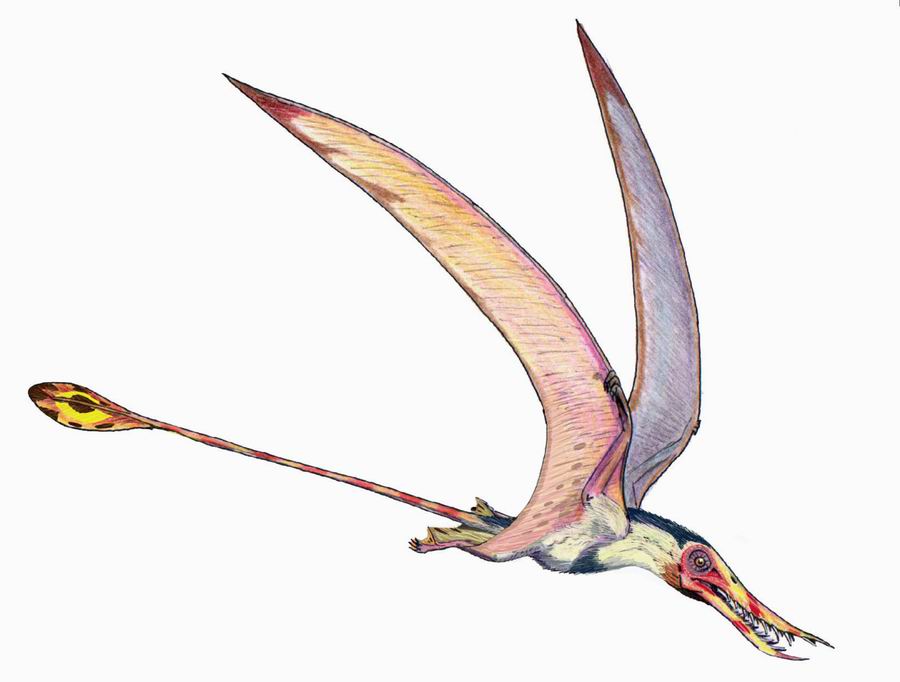- Rhamphorhynchus (pterosaur)
Taxobox
name = "Rhamphorhynchus"
fossil_range =Late Jurassic

image_width = 200px
regnum =Animal ia
phylum = Chordata
classis = Sauropsida
ordo =Pterosauria
subordo =Rhamphorhynchoidea
familia =Rhamphorhynchidae
genus = "Rhamphorhynchus"
genus_authority =von Meyer , 1846
subdivision_ranks = Species
subdivision =
* "R. muensteri" (Goldfuss, 1831) (type)
* "R. jessoni" Lydekker, 1890
* "R. tendagurensis" Peck, 1931
synonyms =
* "Ornithopterus" von Meyer, 1860
* "Pteromonodactylus" Teriaev, 1967"Rhamphorhynchus" (pronEng|ˌræmfəˈrɪŋkəs) was a long-tailed
pterosaur of theJurassic period. Its name means 'beak snout'. Only 17.5 cm (7 in) long but with a wingspan of 100 cm (3 ft), it was less specialized than the laterpterodactyloid s. It had a long tail stiffened withligament s which ended in a diamond-shapedvane ."Rhamphorhynchus" ate
fish ,frogs ,andinsects and it is believed that one of the ways it hunted was by dragging itsbeak in thewater , catching fish and tossing them into its throat pouch, a structure similar to that ofpelican s, which has been preserved in some fossils. This method of catching fish is found today inskimmers .Although
fossil s have been found inEngland , the best preserved come from theSolnhofen quarry inBavaria ; many of these fossils preserve not only the bones but impressions of soft tissues such as the wings and tail."Rhamphorhynchus" laid eggs instead of giving birth to its young. It belongs to the Suborder
Rhamphorhynchoidea .pecies
There are three currently recognized species of "Rhamphorhynchus":Fact|date=March 2007
* "R. muensteri" (Goldfuss, 1831) (type)
* "R. jessoni" (Lydekker, 1890)
* "R. tendagurensis" (Peck, 1931)A number of additional species have been named, but are currently considered invalid:Fact|date=March 2007
* "Rhamphorhynchus longicaudus" (Muenster, 1839)
* "Rhamphorhynchus gemmingi" (von Meyer, 1846)
* "Rhamphorhynchus phyllurus" (Marsh, 1882)
* "Pteromonodactylus phyllurus" (Marsh, 1882)
* "Rhamphorhynchus longiceps" (Woodward, 1902)
* "Rhamphorhynchus intermedius" (Koh, 1937)ynonyms
* "Pteromonodactylus" (Teriaev, 1967)
* "Ornithopterus" (von Meyer, 1860)
* "Ornithocephalus muensteri (Goldfuss, 1831)
* "Ornithopterus muensteri" (Goldfuss, 1831)
* "Pterodactylus lavateri" (von Meyer, 1838)
* "Ornithopterus lavateri" (von Meyer, 1838)
* "Pterodactylus longicaudus" (Muenster, 1839)
* "Pteromonodactylus phyllurus" (Marsh, 1882)*"See also the disambiguation page for
Rhamphorhynchus ."Anatomy
A study in 2003 [http://www.nsf.gov/od/lpa/news/03/pr03124.htm] showed that "Rhamphorhynchus" held its head parallel to the ground due to its
inner ear structure, which helped the animal detect itsbalance , much likehuman s.In popular culture
"Rhamphorhynchus" was featured in the third episode "Cruel Sea" of the award winning "
Walking with Dinosaurs "television series . The reptile is shown living amongst the seaside hunting fish, digging forhorseshoe crab eggs and stripping bark offconifer trees to findbark beetle larvae . It is also shown being hunted by "Eustreptospondylus ".References
* Bennett, S. C. (1995). "A statistical study of "Rhamphorhynchus" from the Solnhofen Limestone of Germany: Year-classes of a single large species." "Journal of Paleontology", 69: 569-580.
External links
* [http://www.nhm.org/journey/prehist/flying/rhamphorhynchus.html Journey Through Time]
Wikimedia Foundation. 2010.
